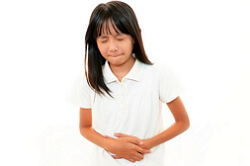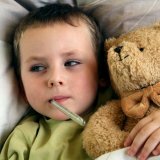Gastritis in children
 Gastritis in children is an inflammatory disease of the stomach in children that affects its mucous membrane. With gastritis in children, first there are violations of secretion and acid-forming function. Then atrophy of the main cells is formed, and violations of the formation of enzymes develop. On the gastric mucosa a large load falls, which is due to the rather aggressive action of the gastric secretion. And the gastric mucosa, on the contrary, has mechanisms to protect against this aggressive influence.
Gastritis in children is an inflammatory disease of the stomach in children that affects its mucous membrane. With gastritis in children, first there are violations of secretion and acid-forming function. Then atrophy of the main cells is formed, and violations of the formation of enzymes develop. On the gastric mucosa a large load falls, which is due to the rather aggressive action of the gastric secretion. And the gastric mucosa, on the contrary, has mechanisms to protect against this aggressive influence.
This disease of the gastrointestinal tract is very common in childhood. Gastritis is more likely to affect adolescents, older preschool children and primary school students. Many parents perceive chronic gastritis as not too serious a problem and do not pay adequate attention to the nutrition of children. But if you take time to diagnose gastritis and select a complex effective treatment, then it will allow you to establish a metabolism, and the child will be able to adequately grow and develop.
Acute gastritis rarely escapes the attention of health professionals, because it has quite bright manifestations.
Causes of gastritis in children
Gastritis in children occurs when the balance between the protective properties of the gastric mucosa and the effect of gastric contents on it, which is quite aggressive, is disturbed.
Heredity plays a big role in the child's gastritis. If one of the parents of the child suffers from gastritis, then the risk of getting sick of such a child is higher.
The second cause of gastritis is Helicobacter pylori. This bacterium belongs to gram-negative microbes. By adolescence, most people in many countries are already infected with Helicobacter pylori. The child is most often infected by the parents themselves through a common dish, when they kiss the baby on the lips. This microorganism begins to cause the disease in the case when the gastric mucosa is already damaged, causing an increased release of hydrochloric acid.
The most significant causes of gastritis development are malnutrition. When a child often eats a sharp, rough, hot, irritating food, fast food, overeats, snacks on the run, eats irregularly, "in a dry-fat", then the protective properties of the stomach mucosa are violated.
The intake of alcohol and tobacco in childhood lead to atrophy of the gastric mucosa, disrupting its blood supply.
To the causes of gastritis in young children can be attributed to improper introduction of lures, frequent changes in milk formula, eating chocolate and abuse of sweets up to 3 years.
Prolonged use of certain medications can cause gastritis( iodine preparations, salicylates and others).
In children, stressful situations are frequent, resulting in the transfer of the contents of the duodenum into the stomach. Bile, thrown into the stomach, causes burns to the mucous membrane.
Less commonly, the causes of gastritis include diseases of other organs, food allergy, autoimmune processes, infection with worms. In addition, there is a hypoxic gastritis caused by respiratory or heart failure.
Symptoms and signs of gastritis in children
Symptoms of gastritis in the child are diverse and specific. Not always children can clearly explain their unpleasant sensations in the development of gastritis. The most significant symptom is pain. Gastralgia is paroxysmal. Pain can vary in intensity and duration. Sometimes the pain is intense, and sometimes it is of a dull character. The child shows that the abdomen hurts above the navel, sometimes to the right of the navel, closer to the hypochondrium. Usually the stomach starts to ache after 20 or 30 minutes after the baby has eaten. The pain that starts 40-50 minutes after eating is called late. With gastritis, they also occur, especially when gastritis is combined with duodenitis. Pains are sometimes given to the left, grasping the hypochondrium, arm, half of the thorax. If too much hydrochloric acid is produced, then a peculiar rhythm of pain arises, which is called Moinigan's: "hunger-pain-food intake-relief-hunger-pain. .." Such pains in the abdomen are more common in adolescents. They arise after eating fried foods, with overeating, jumping, fast running.
Very rarely with gastritis, the temperature rises. Children with this disease often lose weight, look weakened. Sometimes children, tired of frequent abdominal pains, become irritable.
In addition to the child's pain, nausea, belch fat or sour, heartburn, loss of appetite, diluted stools can be disturbing. Heartburn children describe as unpleasant sensations behind the sternum, burning. There may be putrefactive odor from the mouth. Gastritis in children is accompanied by poor tolerance of fatty foods. Vomiting with gastritis is rare.
Exacerbation of gastritis in children is usually in the spring and autumn months.
Acute gastritis in children
Acute gastritis in children is called the inflammatory process of the stomach, affecting its mucous membrane and arising suddenly. This condition has become increasingly common among the child population and occurs for the first time at an earlier age.
Infectious diseases of the digestive tract are one of the most significant causes of acute gastritis. Dangerous microorganisms secrete toxins that damage the gastric mucosa. These include salmonella, Escherichia coli, Proteus, Staphylococcus aureus and others.
Food poisoning( toxicoinfections) is the second cause of acute gastritis. When eating foods with expired shelf life that have not undergone sufficient heat treatment, as well as products that have been stored improperly, toxins that trigger the disease are secreted.
Sometimes acute gastritis in a child may occur as a side effect on certain medicines. These include antipyretic drugs and other NSAIDs, Aspirin, hormonal drugs.
Acute gastritis can occur if accidentally poisoned with household chemical products.
In young children, acute gastritis can occur when maltreatment is introduced, if there is a violation of the rules for switching to artificial feeding, with food allergies.
Signs of gastritis in a child with acute gastritis are quite bright. First of all, this is a severe pain in the abdomen, more often in the navel and above the navel. The second very significant symptom is vomiting of undigested eaten food. Vomiting can be repeated, it brings relief to the child. Often the temperature rises, diarrhea arises.
When examining a child with a gastritis, one can see a tongue lined with a white coating, pale skin. Often there is tachycardia, lowering blood pressure. The child reacts negatively to the examination of the abdomen, to the touch. Breast children are restlessly behaving, crying, not taking a breast or a bottle.
If gastritis is caused by an allergy to an agent, you can notice other signs of an allergy-rash on the skin, itching.
The most dangerous is acute gastritis caused by the intake of chemicals not intended for ingestion. In this case, it is accompanied by a burn of the esophagus, pharynx. The pain is very intense, vomiting can be with an admixture of blood.
Chronic gastritis in children
Chronic gastritis in children is a long-term inflammatory process of the stomach, affecting its mucous membrane and leading gradually to its depletion( atrophy).Subsequently, to ensure good digestion and adequate metabolism, the affected mucosa can not. Inflammation can be localized only in one of the stomach sections or be spread out.
Gastritis in children with a chronic course of the disease is divided into primary and secondary. Children are more likely to develop primary gastritis. Primary gastritis is an independently occurring disease, in which the primary focus of inflammation is in the stomach. With secondary gastritis, the inflammatory process first has other organs, only then the stomach is involved. This separation of gastritis is very important, because primary and secondary gastritis initially requires a different approach to therapy. The focus on the treatment of the underlying disease is mandatory in the treatment of secondary gastritis. Therapy of primary chronic gastritis has its own treatment regimens.
Since chronic gastritis is rarely an isolated condition, the pancreas, the bile ducts or the duodenum are almost always involved. If gastritis is combined with duodenitis, it can be "a symptom of slippage" - the urge to defecate during meals or immediately afterwards.
Acidity of gastric contents in chronic gastritis in a child can be elevated, decreased, or normal.
Dysfunction, dietary error, monotonous nutrition, prolonged treatment with certain medications, smoking, drinking alcohol, worm infestation, stress, family problems are the main prerequisites for the child's chronic gastritis.
The abovementioned prerequisites of the disease in combination with the infection of Helicobacter pylori are a serious problem leading to a chronic course of the process.
Characteristic of the onset of the disease in a child when he first goes to school. At this time, the food regime changes dramatically.
The most important signs of the disease are late pains above the umbilical area, pain at night. Stupid pains after a child has taken food that are diffuse in nature, occur with gastritis with low acidity. If the secretory function of the mucosa is normal or increased, the pain is sharp, paroxysmal. Chronic gastritis is accompanied by heartburn, sour belching, loss of appetite. The chair becomes unstable, constipation is frequent. Examination of the abdomen in the child reveals soreness in the perigapic and pyloroduodenal zones. Given the duration of the process, hypovitaminosis and anemia can begin.
Diagnosis of gastritis in children
Diagnosis of gastritis in children is based on the collection of child complaints, a history of the disease and the results of additional studies. Clarify the nature of the process for gastritis in children help following methods:
- Fibroezofogogastroduodenoskopiya( FEGDS) allows you to see the swelling and redness of the mucous membrane of the stomach, presence of erosions, hemorrhage, exhaustion of foci( atrophy), to identify the prevalence of pathological process, the presence of the cast of duodenal secretion in the stomach, Evaluate the work of sphincters of the stomach. When FEGDS can pick up material for morphological diagnosis
- Identification of pathogen Helicobacter pylori gastritis possible by detecting specific antibodies in the blood or feces of the child by ELISA and other rapid tests. Respiratory tests are used to record the concentration of the products of the microorganism's vital activity( ammonia, carbon dioxide).The most accurate method of detection is the detection of Helicobacter pylori bacteria in the gastric mucosa tissue specimens using Giemsa stain bacteria, Ghent and Vartinu-Starry. Furthermore, cytology is used
research method - pH meter determines the acidity of gastric juice
- X-ray examination of the stomach with barium makes it possible to assess the state of the gastric mucosa and duodenal ulcers.
- gastric sounding allows to characterize the secretory activity of the stomach
- Microscopic examination of gastric juice reveals accumulations of erythrocytes, increased number of leukocytes in a long-term process
- ultrasound of the abdominal cavity allows revealing other affected organs
- General blood test notIs specific for gastritis. You can identify leukocytosis, anemia.
- Coprogram - detection of undigested muscle fibers, eggs, worms
- Study of the vegetative status, consulting neurologist
gastritis treatment in children
Treatment of acute gastritis in children should be performed in a hospital. This is the responsibility of the pediatrician, often in conjunction with an infectious disease specialist. It is not uncommon for cases when it is necessary to restore a serious condition in the department of children's intensive care. Treatment of acute gastritis in children depends on the cause that led to the disease. Should not get out of bed 3-4 days. In case of persistent vomiting intravenous infusions are prescribed, correction of electrolyte blood composition. In case of poisoning with poor-quality food or chemicals, gastric lavage is used. With a very sharp
gastralgiyah apply antispasmodic( No-spa, papaverine), antacids( Almagel, Maalox).Adsorbents are very effective( Smecta, Polyphepan, Activated Carbon).To stop vomiting, introduce Cerucal or Motilium.
With gastritis, which have the infectious nature of the disease, antibacterial therapy, vitamins B, enzyme therapy are prescribed.
Outpatient or day hospital treatment for chronic gastritis in children. The following medicines are prescribed:
1. Means that neutralize aggressive hydrochloric acid. To the group of these means belong anatacids.
- Means containing aluminum phosphoric acid salt( Fosfalugel, Alfogel)
- Preparations with aluminum hydroxide and magnesium hydroxide content( Maalox, Remagel, Gastal, Almagel).Aluminum and magnesium have the ability to extinguish hydrochloric acid.
- A preparation containing alginic acid( Topaal)
2. Regulators of gastric and duodenal motor function.
When throwing duodenal juice in the stomach apply prokinetics( Motilium, Cerucal).
Exacerbation of gastritis in children is often accompanied by pains of spasmodic nature. In this case, peripheral cholinolytics( No-shpa, Papaverin), meotropic antispasmodics( Debrideat) are effective.
3. Drugs that inhibit the release of hydrochloric acid:
- H2-histamine receptor blockers( Ranitidine, Famotidine)
- Proton pump blockers( Omeprazole, Losek, Pantoprozole)
- Blockers of selective M-cholinergic receptors( Gastrotsepin)
4. Drugs, Which form a protective layer on the gastric mucosa( Venter, De-nol).De-nol, in addition, has anti-Helicobacter action.
5. Treatment of Helicobacter pylori infection. Specific antibiotics are applied that not only effectively affect the microorganism, but are resistant to the effects of gastric juice, penetrate well into gastric mucus, have a local effect on the mucous membrane, are quickly eliminated from the body, do not accumulate in other tissues. Such antibiotics include Metronidazole, Clarithromycin, Amoxicillin, De-nol, Tetracycline, Pilorid and inhibitors of the "proton pump".
There are different treatment regimens for Helicobacter pylori. A one-week, three-component Helicobacter eradication scheme includes De-nol in combination with Macmoror, Furazolidone, or Metronidazole. The scheme involves taking one or two antibacterial drugs or an antisecretory drug and two antibiotics.
There is a one-week three-component scheme without the use of bismuth preparations. It contains an antisecretory drug + Nifuratel, Furazolidone or Metronidazole + Amoxicillin;Antisecretory drug + Nifuratel + macrolides( Clacid);Blockers of the proton pump( Omez) + Amoxicillin and macrolides.
If this one-week treatment regimen is not effective, then quadrotherapy is prescribed for a week. It includes all three-component medications and a bismuth drug( De-nol).
6. Correction of a dysbacteriosis that has arisen as a result of antibiotic treatment( Enterol, Lineks, Hilak forte).
7. Treatment with mineral waters. If the acidity of the gastric juice is increased, then water of poor mineralization is shown. It needs to be heated, to release gases, to take before meals( for 1 - 1.5 hours) 3-4 r / d. With reduced secretion, drink warm mineral water Essentuki №4 or №17 before meals( for 15 - 30 minutes) 3-4 r / d. In the case of normal acidity, mineral water is weakly mineralized for 45 to 60 minutes before meals, 3-4 p / d. In this case Borjomi, Smirnovskaya, Essentuki No. 4, Narzan will do. It is necessary to multiply by 10 the age of the child( in years), in order to obtain a single amount of mineral water per reception( in ml).The course of repeated treatment with mineral water is 4-6 months, for 30-45 days.
8. Phytotherapy with gastritis with decreased secretion includes leaves of plantain, root of elecampane, grass of oregano, yarrow. With increased acidity, St. John's wort, gastric gathering is used. Treatment courses are repeated 2 or 3 times a year for 10-14 days.
9. Non-drug treatment of chronic gastritis in children
Correction of autonomic disorders( psychotherapy) is of great importance for the formation of an adequate response to the disease. During the treatment sessions, the doctor learns about the nature of the child, the emotional situation in the family, relationships with classmates, that is, identifies possible causes of the child's stress, which could trigger the onset of the disease. Then the therapist strives to harmonize his relationship with the social environment.
After a meal, a child should take a walk, do not lie down after eating. A child needs a healthy sleep, go to bed no later than 21 hours. In the prone position on the left side or lying on the back, reflux of the duodenum to the stomach is amplified, so you should avoid such poses in a dream. Well, if you can raise the head end of the bed.
Physical stresses should be moderate. You can not participate in competitions, go to sports clubs, ride a bicycle, run intensely, lift weights. It is allowed to skate, swim, engage in tourism and play moderately mobile games.
Clinical examination for gastritis in children allows you to monitor whether treatment is effective. In the first year of the disease, twice a year the patient should be examined by a gastroenterologist. The pediatrician examines the child at least once a quarter. The otorhinolaryngologist and dentist are obliged to look at the child at least once, in time to identify foci of infection in the ENT organs and to cure carious teeth. At the end of the first year of observation, the pH-metry and PHEGS are performed once. According to the testimony, Helicobacter diagnostics are repeated by express tests.
In the second year of illness the pediatrician examines the child 2 times a year, and the ENT doctor, dentist and gastroenterologist - 1 time. After the second year of the disease, PH-metry and PHEGS are repeated, according to the indications - Helicobacter diagnosis.
In the third year of observation, all specialists examine the child once, and additional diagnostic methods are performed if necessary.
Diet for gastritis in children
The gastric mucosa has a high ability of tissue regeneration. When it is damaged, then this ability is lost. Proceeding from this, it is necessary to adhere to the main rule of a diet at a gastritis at children is a shading of a mucous membrane. The mucosal cutting can be mechanical and chemical.
Mechanical shchazhenie means careful selection of food products and limiting their single volume. It should be as much as possible to limit or exclude vegetables from vegetables that contain rough peel( turnip, radish, beans, peas, radish), unripe fruits and berries( grapes, currants, gooseberries), whole-grain bread.
It is necessary to reduce the presence of raw vegetables and fruits containing a lot of fiber and vegetable fibers( plums, apricots, dried fruit, cabbage) in the ration of the child.
The cartilage, skin of birds, and wiry meat should be excluded from the ration of the child.
Nutrition for gastritis in children implies special ways of cooking( rubbing, mashing, boiling until soft, sprinkling, blanching, steaming).It is necessary to feed the child more often, but in small portions.
Chemical shining of food implies a selection of food products, focusing on the functional activity of the glands of the stomach.
It is necessary to exclude foods from food that cause very strong gastric secretion. These are products containing extractives( mushrooms, broths, mayonnaise, sauces, fried foods);Products containing in its composition essential oils( spices, smoked products, chocolate, coffee, cocoa, radish, onions, garlic, sorrel, horseradish, parsley, etc.);Black bread, soft buns, nuts;Concentrated juices, lemonade, strong tea.
It is recommended for gastritis dishes, which weakly excite gastric secretion. These include boiled fish, well-boiled meat, milk and milk dishes, omelet, soft-boiled eggs, white crackers, weak tea, alkaline mineral water without carbonic acid.
You should pay attention to the temperature of food. Cold dishes depress the function of the glands of the stomach, slowing the recovery properties of the epithelium. At an exacerbation it is necessary to adhere to temperature of accepted food within the limits of 30-40 ° С, during remission - 20-60 ° С.
When the child begins to recover, it is recommended to expand the food in a zigzag manner. This implies the expansion of the diet for a short period, followed by a return to a sparing diet. This nutrition with gastritis in children is considered a training, it revitalizes the regenerative capacity of the stomach.
In addition, compiling a menu of a child suffering from gastritis, it is necessary to take into account his needs for the basic ingredients of food and calorie according to age. Meals must satisfy the needs of the child. The deviation from this rule is possible only for a short time.
Prevention of gastritis in children
To avoid a child's gastritis, it is necessary to adhere to a whole range of preventive measures.
It is necessary to take care of the digestive tract of the child from an early age. It starts with the correct introduction of complementary foods, which must be introduced in a timely and correct manner.
From an early age it is necessary to instill in the child useful eating habits: to observe a diet, to chew food well, not to eat in a draft, in a hurry and on the run. It is necessary to conduct explanatory conversations at school and at home with children about the culture of nutrition, the benefits and harms of various foods. Since children always follow the examples of their parents, good food habits need to be vaccinated not only for the child, but for all household members.
Proper cooking of food, consumption of only fresh products in the diet can reduce the risk of gastritis.
Modern children can not be saved from chewing gum, chips, hot dogs, soda and crackers. Therefore, children should be fully informed about the dangers of these products, use them extremely rarely and strictly dosage.
Combating smoking in childhood and drinking alcoholic beverages is also a step towards fighting gastritis.
At home in a safe place, household chemicals and medicines should be stored to avoid accidental poisoning.
It is necessary to teach children to observe personal hygiene, to thoroughly wash hands, vegetables, fruits, to avoid the occurrence of intestinal infections.
From an early age it is necessary to strive to observe the regime of the day and rest, to accustom to the order of the child. The child should get enough sleep and go to bed at the right time. Do not overload the child with developing circles and sports sections. Every day should be allocated time for a walk, outdoor games on the street.
As the exacerbation of gastritis in children can cause stress and anxiety, problems in dealing with friends or teachers, one should try to help resolve conflicts, support the child and criticize less.



